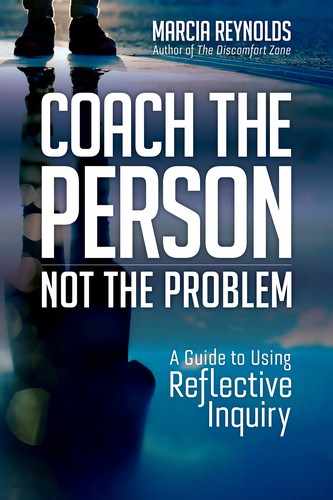PART II
The Five Essential Practices
When we question what we know, we are open to learning. We just don’t do this well when left to figure things out on our own.
—MARCIA REYNOLDS
MANY COACHING MODELS can lead to a satisfying outcome for the client. Just creating a safe space for people to pause and sort through their thoughts can be beneficial. Coaching models provide value if three goals are met: (1) an outcome for the coaching session is identified, even if it evolves; (2) blocks, or what needs to be resolved by the client, are discovered; and (3) an achievable next step is articulated.
These three goals of all effective coaching models provide focus and movement in the coaching conversation. The outcome defines what the person wants to get as a result of the conversation. The blocks are the emotions, beliefs, or conflicts that are deterring the client from achieving the outcome. Specifying and committing to take at least one step forward ensures progress between sessions even if the next step is “I need to take time to think about it.”
Identifying an outcome, sorting through options and consequences, and then making a plan can be used for basic problem-solving. We call this coaching at a surface level, or transactional coaching. These types of conversations are beneficial, especially when clients are verbal processors—people who need to think out loud—and they feel safe talking with you. I sometimes have these conversations with my clients but not all the time. Being a sounding board in every session is not worth their money or my time. The coaching stays focused on the problem, not the people who see the situation as a problem.
What is more useful is to utilize my coach training and experience to look at what is making this situation a problem they can’t sort out on their own. How is their thinking contributing to the dilemmas they are facing? The second step in the coaching models differentiates coaching from problem-solving. The methods used to discover what needs to be resolved by the client are key to transforming thinking. We coach people to see the Five essential Practices the problem and possibilities in new ways. Clients gain a broader view of themselves and their circumstances, changing how they handle their interactions and decisions going forward.
TRANSACTIONAL VERSUS TRANSFORMATIONAL COACHING
Transactional coaching occurs when you assist clients to explore their thoughts about a situation so they can decide what to do, or not do, next. The conversation tends to follow a logical progression. You use a lot of “if . . . , then,” “for what reasons,” and “what else is possible” prompts for analysis. Clients may look backward to discern factors that led to the present moment. You may guide them to look forward to what might happen next and after that and after that. You might even explore the present moment to help clients separate what is feasible from what is a pipe dream.
No matter what direction you take, transactional coaching is linear and externally focused on the problem. Such conversations skim the surface instead of delving into the clients’ thought patterns, biases, and emotional filters. Clients might thank you and commit to an action plan. However, once they face their daily dilemmas, the plan is often altered or forgotten.
Not every conversation needs to explore beliefs and blocks, but even a little dip in the pool to test an assumption or recognize an avoidance is useful. When people live with beliefs and behaviors for a long time, a transactional, problem-solving approach to change is not effective. Neuroscientist Michael Gazzaniga says we spend our days in automatic thought processing, rarely stopping to question the reasoning for our choices. Even when we do, our brains resist self-analysis to keep us feeling safe and right, even if we have a sense that our excuses are irrational. Someone outside our brains is needed to break through these protective devices with a transformational approach.1
Transformational coaching works from the inside out. Reflective inquiry is a powerful way to create the disruptions in thinking that lead to breakthrough transformation and change. This is when coaching feels magical.
Using reflective inquiry, clients see their beliefs as if they were laid out on a table to examine. From this vantage point, they can see the holes in their logic or an outdated point of view. Further reflections and questions may reveal unspoken fears, needs, and desires. How clients frame reality morphs as they form new perceptions and beliefs.
Coaching the person, not the problem, by using reflective inquiry is the cornerstone of transformational coaching. The five essential practices described in the next five chapters will give you the reflective inquiry tools you need. Using these tools will improve your coaching no matter what school you attend and model you use. The reflective inquiry toolbox includes the following:
- Focus—coaching the person, not the problem
- Active Replay—playing back the pivotal pieces for review
- Brain Hacking—finding the treasures in the box
- Goaltending—staying the course
- New and Next—coaxing insights and commitments
